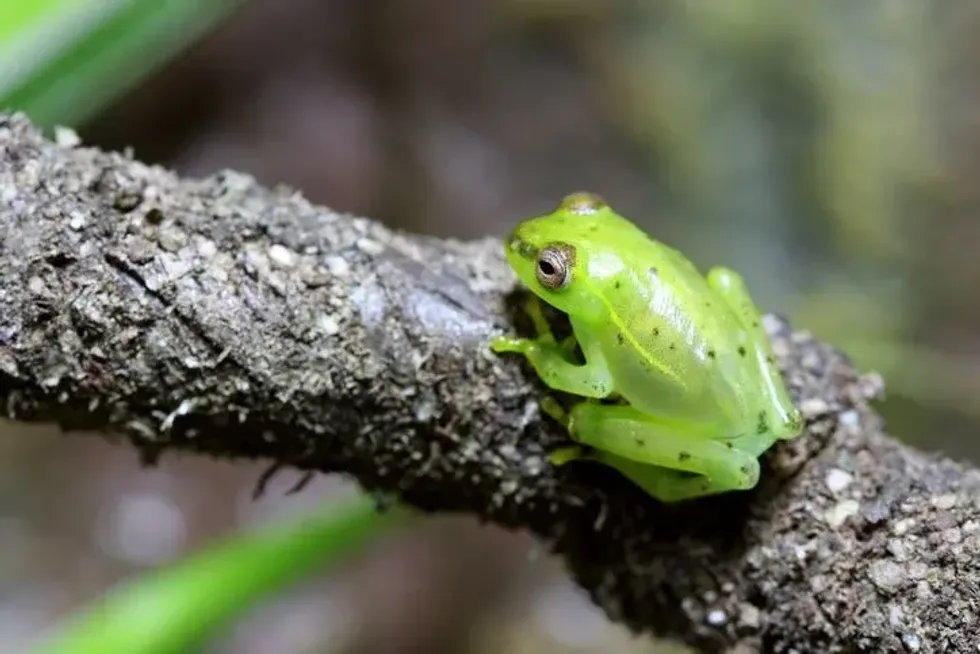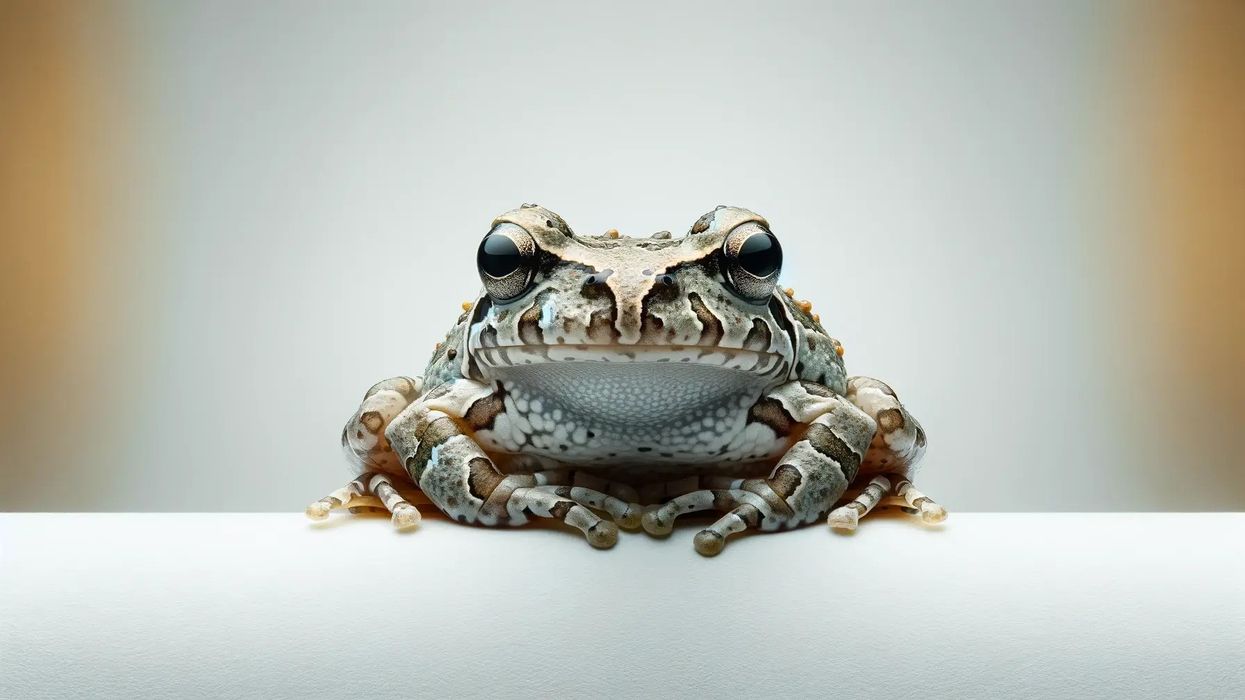The term 'glass frog' is used to describe a number of species of frogs in the Centrolenidae family that live in the tropical rainforests of Central and South America. These frogs are known mostly for their distinct physical features.
They are very tiny and have mostly green skin. You can also find glass frogs with different colored spots on them.
But the glass frog's most interesting feature is that certain species of glass frogs have translucent or transparent skin on their bellies and their organs can be seen through them. There are a few subfamilies of these Frogs.
Centroleniae, Hyalinobatrachium are a few important and popular subfamilies. If you want more interesting glass frog information, then read this article for more great glass frog info.
If you want to read more interesting frog facts then check out these amazing articles on the tree frog and pool frog.
Glass Frog Interesting Facts
What type of animal is a glass frog?
Glass frogs are a type of frog from the Centrolenidae family (Order Anura).
What class of animal does a glass frog belong to?
The glass frog belongs to the Amphibia class of the Animalia kingdom.
How many glass frogs are there in the world?
The exact number of glass frogs in this world is unknown. But there are almost 60 species of the glass frog in Central and South America and Mexico. They are not extinct but some species are on the verge of extinction due to extreme deforestation. Some species are considered to be endangered.
Where does a glass frog live?
Glass frogs can be found all over Central and South America and also Mexico. They are found in Costa Rica, Belize, Panama, Colombia, and Guatemala. Some species can also be found in the Amazon, especially in Brazil, and Argentina.
What is a glass frog's habitat?
The ideal habitat for the glass frog is a rainforest. They are found in the humid rainforests of Central and South America. Being arboreal creatures, glass frogs are often found on the underside of leaves.
Most glass frogs appear light green when viewed from above. Some species also have translucent or transparent bellies that earn them their names.
Since they are arboreal, their bodies help them to stay camouflaged in the leaves. These amphibians like to live close to water bodies. So most glass frogs will be found close to forest streams, in small trees or shrubs.
Who do glass frogs live with?
Glass frogs often live in small groups. A group of frogs is called an 'army'. But male glass frogs can be really territorial during mating season. They mark their territories by some specific calls.
How long does a glass frog live?
Though the lifespan of a glass frog can vary between species, the average lifespan of these frogs is about 10-14 years. The glass frog life cycle is pretty long for such a small creature. If they are not hunted and eaten by glass frog predators such as snakes and birds their life is pretty long.
How do they reproduce?
The reproduction process can vary based on the different glass frog species. But the main event is more or less the same for all of them.
The mating season for glass frogs begins when first rainfall hits the forests. At this time, male frogs descend from their spot on high leaves and come closer to the stream and try to sit on a big leaf by the stream.
After acquiring a space, the males will emit noises that attract the females. If the female is interested, she will join the male and they start the mating process.
After the mating, the female pregnant glass frog lays eggs in a clutch that may have up to 30 eggs in it.
The male frog then fertilizes those eggs. During the gestation period of these eggs, which can be weeks, the males stay patiently on the leaves and guard the eggs.
The females go back to the high leaves after laying their eggs. After being gestated for enough time, the tadpole embryos break out of the eggs and go into the bottom of the stream.
They grow for months and those that survive come back to join the other glass frogs in the trees. There are some predators that feed on glass frog eggs and tad
What is their conservation status?
Glass frogs are not extinct. There are a lot of species of glass frogs found in Central and South American rainforests. Some of them are endangered and that is mostly because of loss of habitat.
Due to deforestation, a lot of these beautiful frogs have fallen victim to habitat loss and pollution. Which has resulted in a drop in their numbers. But some organizations are trying to help these species live peacefully in their homes.
Glass Frog Fun Facts
What do glass frogs look like?

Glass frogs have very distinct features that can help us identify them in the wild. They mostly live in the tropical rainforests of Central and South America.
These arboreal frogs live underneath the leaves of the trees by forest streams. The glass frog size is very tiny. They are about 1-3 in (3-7.5 cm) long.
And only a few larger species can reach three inches in size. They are also very light.
Most species of glass frogs are light green or lime green in color. But the most distinct feature of the glass frog is that they have transparent or translucent skin on their bellies.
The main reason behind this glass frog adaptation is unknown, but it is speculated that the transparent or translucent skin of these frogs, coupled with their green skin, helps them to be camouflaged from the numerous predators that hunt them in these forests. The translucent skin cannot be found in every species of glass frogs.
But through this transparent or translucent skin of their bellies, we can see their internal organs from underneath them.
Depending on the species, their organ can be of different colors as well. Another glass frog adaptation is that they can jump very high despite their tiny bodies.
How cute are they?
The glass frog is a very cute species of frogs. They are very small in size and their unique color and features make them fascinating creatures. You can hold them in the palm of your hand easily. They can be kept as pets but they need special care. But all in all, they are really cute.
How do they communicate?
Like other frogs, this amphibian also communicates through calling. The male frog makes sounds to attract the female frog during the mating season.
Not much is known about the communicative habits of the females as they are seen more rarely than males. It has been found out recently, that they also communicate via waving to each other. This has taken the internet by an adorable storm.
How big is a glass frog?
The glass frog's size depends on the species. But mostly they are very small. Their average size ranges from 1-3 in (3-7.5 cm). The larger species reach three inches but mostly they are smaller. There are more than 60 species that have been identified already but there are most likely more of them.
How fast can a glass frog swim?
Being arboreal amphibians, glass frogs can swim pretty fast in small rivers and forest streams. Glass frog tadpoles are born with strong bodies that help them swim through harsh streams.
How much does a glass frog weigh?
The glass frog's weight varies depending on the species. But usually, they are very light, considering their size. These transparent frogs are typically 0.2-0.5 oz (5-14 g) in weight.
What are their male and female names of the species?
There are no distinct names for the males and females of frogs. Naturally, they are called male and female glass frogs. But a group of frogs is called an army.
What would you call a baby glass frog?
Like every other frog baby, the young of the ghost glass frog is called tadpoles. Tadpoles need about 10 months to become frogs.
What do they eat?
The glass frog is a carnivorous animal. This means this species lives by feeding on small insects. Glass frog food consists of moths, crickets, ants, spiders, and even smaller tree frogs.
Are they poisonous?
No, they are not poisonous. Among the known species, no glass frog is poisonous. You can hold them gently in your hand without worry.
Would they make a good pet?
Glass frogs are tiny and need to be fed small insects. They can sit on the palms of your hand and they are also very cute.
All of this makes them ideal to have as pets. But there are some cons as well. Since the glass frog is an arboreal amphibian from tropical rainforests, you will need to create an ideal space for them to survive in captivity.
Some species of glass frog are considered to be endangered and thus, they cost a lot. But even if you cannot keep glass frogs as pets, they are still mesmerizing creatures that need to be saved from extinction.
Did you know...
Some glass frogs might have white, black, or other colored spots on their green skin, such as the white spotted glass frog.
Depending on the species, some glass frogs might have green or white bones.
What can be seen through a glass frog's skin?
Depending on the species, we can see the hearts, livers, and intestines of glass frogs with transparent or translucent skin if we look at them from underneath.
Do glass frogs ever come down to the ground?
Glass frogs are primarily arboreal. Though they are amphibians, they mostly live on the underside of leaves of trees by forest streams. But they do come down from the trees to streams during the mating season. They sit close to the water body on big leaves.
Here at Kidadl, we have carefully created lots of interesting family-friendly animal facts for everyone to discover! Learn more about some other amphibians including American toad, or Surinam toad.
You can even occupy yourself at home by drawing one on our Glass frog coloring pages.










